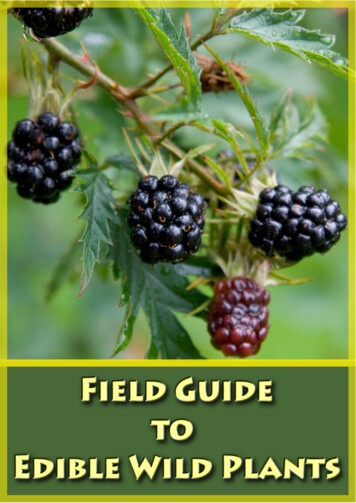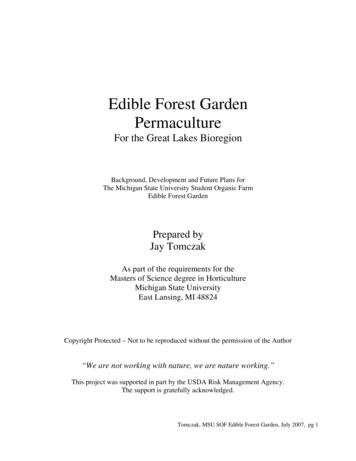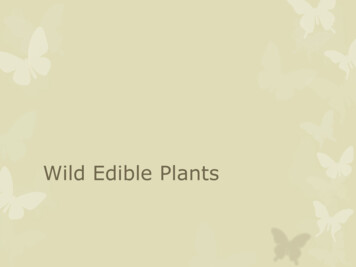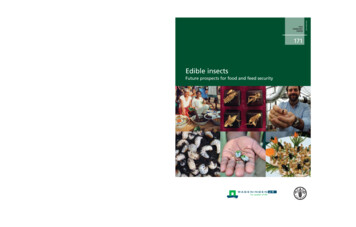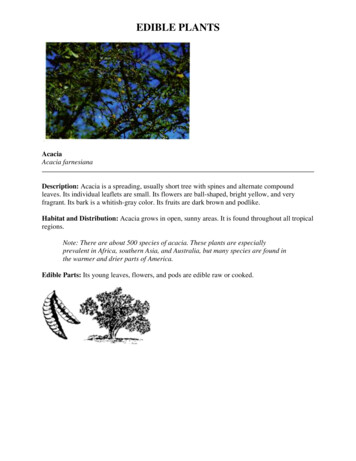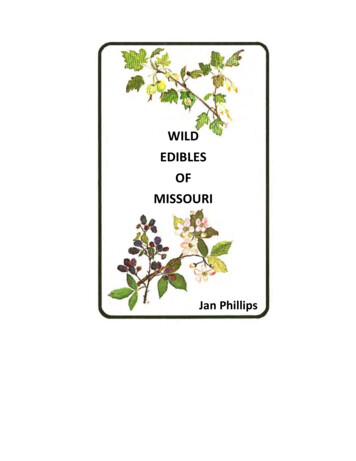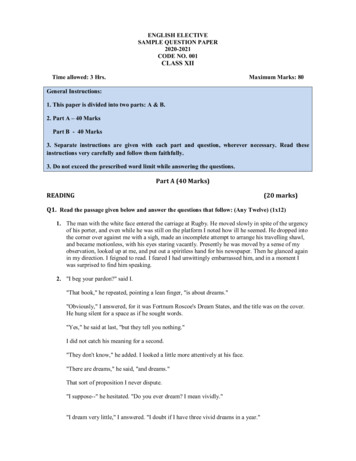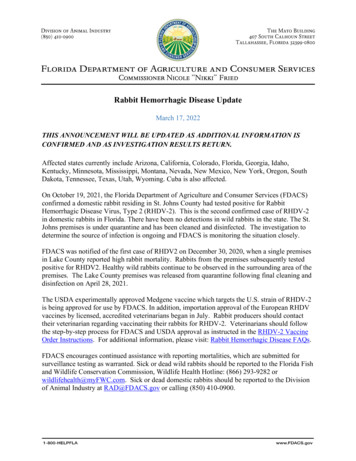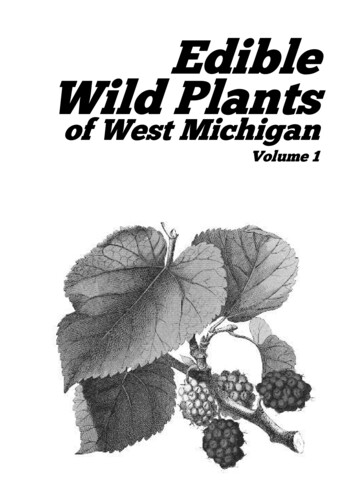
Transcription
EdibleWild Plantsof West MichiganVolume 1
IntroductionThis a short guide to identifying, foraging, harvesting, and using edible andmedicinal wild plants that can be found in the area currently known as WestMichigan. All of these plants have been found either within the city limits ofGrand Rapids or within a short distance. They’re easy for beginners to find andunless noted, there are no (as long as you cross-reference if in doubt) poisonousor toxic look-a-likes .We decided to put together this zine in order to have an easy-to-reproduceintroduction to edible and medicinal wild plants. Sometimes it can beoverwhelming to go out into the woods with a field guide and to try to identifyeverything that you see. Instead, we encourage people to start with a few varietiesand familiarize themselves with more over time. While it may take a little bit ofpractice to learn how to identify wild plants, it's an easy and rewarding processthat we strongly encourage people of all ages to undertake.The indigenous cultures who lived in this area had an intimate knowledge of theland, the plants, and the animals that inhabited it. In contrast, the majority of usliving in this current society have a disconnected relationship with the land inwhich it is something to fear, be skeptical of, and to shape for our own purposes.Clearly, the former is the better approach and one that raises the question ofhow we might act differently if we had a different orientation towards the land.Would we allow the land we are a part of to be destroyed via fracking, mining,industrial production, etc? Hopefully this zine is one small part in re-thinkingour relationship with the land.A Note on UsageThis obviously isn't a full-fledged field guide, nor are we experts. It is meant tobe a brief introduction. To help with identification, we have included linedrawings for most plants as well as at least one picture. There are additionalpictures (in color) on our website for each plant listed in this guide -profiles/If you would like additional help identifying these and other plants, we suggestyou purchase a field guide.Plants Contained in this VolumeThe plants covered in this volume are:Ramps (Wild Leeks), Wild Garlic, Wild Asparagus, Lamb’s Quarters,Juneberry, Wild Bergamot, Black Raspberry, Blackberry, Purslane, Dandelion,Hen-of-the-Woods, Dryad’s Saddle, Chicken-of-the-Woods, Blue Violet, andCrabapple.
RampsRamps are a popular wild food that is easy toforage. They are also known as “wildleeks” (allium tricoccum). Ramps are aperennial onion with a garlic-like odor thatgrow in rich moist soils in deciduous woodsthroughout most of Michigan and the greaterregion. Ramps are edible in the spring, summer,and fall season.IdentificationRamps are found growing in patches in thespring. They have 2 to 3 broad, smooth, lightgreen, onion-scented leaves in the early spring(resembling a “Lily-of-the-valley”, which actually is poisonous). The broad, smoothleaves grow off a stem that has a burgundy or reddish-purple tint. As the summercomes, the leaves of ramps begin to whither away as the leaves on nearby treesgrow and crowd them out. A six-inch to one-and-a-half foot flower stalk supportinga small cluster of flowers grows on ramps in the summer. Ramps are often found onhillsides near streams.HarvestingThere are two parts of ramps that are usable: the leaves and the bulbs. In the spring,the leaves can be harvested and used in a variety of different ways (a commonexample is pesto). The bulbs can also be harvested in the spring or harvestedthroughout the year. They can be used in place of onions or leeks in soups or inother ways. To harvest ramps, dig them up with a small shovel. Or to use the leaves,simply remove the leaves.
Wild GarlicWild Garlic (allium vineale)is acommonly found plant throughoutMichigan. It is commonly found growingin full sun in fields and along roadsides.Wild Garlic is also frequently known asCrow Garlic. It is distinguished by itsstrong onion/garlic odor and parts of theplant can be used throughout the year.IdentificationWild Garlic comes up early in the springwhen its leaves can be used like chives.Wild Garlic grows to be 12 to 18 inches tallwith hollow gray-green leaves (whichtend to be tough) emerging from a smallbulb.Wild garlic has a strong smell of garlic and onion that comes from all parts of theplant, but especially the bulb. As wild garlic grows throughout the season, it beginsto produce flowers.HarvestingAll parts of Wild Garlic can be eaten, depending on the season. In the spring, leavescan be used like chives. In the summer, the flowers can be used in salads. To use theleaves and the flowers of Wild Garlic, just cut them off.To use the bulbs in place of garlic, pull the plant from the ground. When you pullthe plant, you will find a bulb that resembles domesticated forms of garlic. Therewill often be a main bulb surrounded by smaller bulblets. To use the bulbs, peel thepapery coating off as you would with other types of garlic. The bulblets can beplanted to help keep the plant growing and can be incorporated into a garden.
AsparagusWild asparagus (asparagus officinalis) canbe found throughout West Michigan alongroadsides, in fields, and along fence rows.Wild asparagus tends to have a bitsweeter taste than cultivated asparagus.Asparagus is best harvested in the spring,but it can be identified for futureharvesting throughout the summerseason.IdentificationWild asparagus is a soft, feathery plantthat grows about two to six feet tall. It hasa fern-like appearance with side branchesevenly spaced along a central stalk thattapers as it nears the top.Each plant grows several stalks that resemble the asparagus that most people arefamiliar with. As the growing season continues, wild asparagus produces berriesthat eventually turn red.Here is a close up of an asparagus shoot:HarvestingWild asparagus is harvested best in the spring in late April through May. Its shootslook similar (albeit generally a bit skinnier) than the asparagus that is grown ingardens or on farms. Break off the shoots when they are four to six inches tall.In the spring, search for brown, dead foliage of the previous year's growth and lookat the base for new shoots.Asparagus will send up shoots throughout the summer, so one may occasionally
find a shoot or two during the summer season.It can be eaten raw (it tastes surprisingly good) or can be prepared the same ascultivated asparagus.Lamb's QuartersLamb's Quarters (Chenopodium album) is acommon plant across Michigan. It's foundalmost anywhere from spring to fall ondisturbed soil, in fields, along roadsides andtrails, in vacant lots, and parks. If you garden,chances are that you know Lamb's Quarters asa prolific weed. However, like many “weeds”it is actually a beneficial plant. It is high inVitamins A and C, riboflavin, niacin, calcium,manganese, potassium, and iron.IdentificationLamb's Quarters is an odorless branchingplant that eventually grows 3 to 10 feet tall.The leaves are variable, with the upper leaves being narrow and toothless and thelower leaves being roughly diamond -shaped and broadly toothed.A distinguishing feature of Lamb's Quarters are the underside of its leaves, whichare often mealy white (almost lavender like):As the plant grows, it develops small, greenish ball-shaped flowers that eventuallyturn reddish in the fall. Once the flowers turn reddish, they develop black seeds.
HarvestingTo harvest Lamb's Quarters, pull off the leaves. The younger leaves are the best.Lamb's Quarters are excellent steamed for 5 to 10 minutes, as they have a taste thatresembles a more nut-like spinach. They can also be sautéed or used in any recipethat calls for spinach. Like all greens, they cook down quite a bit, so you may wantto harvest more than you think you need.In the fall, the seeds can be harvested and used as a grain. Like the leaves, they arehighly nutritious.JuneberriesJuneberries (Amelanchier) are easy-to-find multi-stemmed shrubs and trees thatare found widely across Michigan. Also known as Serviceberries, Juneberries arewidely planted as ornamental trees but also occur in the wild. They have blueberrylike fruits that can be harvest in June. The berries have a flavor that tastes like acombination of apples and blueberries while the seeds have an almond-like taste.IdentificationJuneberries are small shrubs or trees. They have opposite, stalked, oval, toothed,pointed leaves that grow about two inches long. In the spring, white five-petalflowers appear before the berries.The berries have a crown on the side of the stalk that makes them easy todistinguish. They are about ¼ to 1/3 inch across resembling blueberries. They startred and later turn a blue/black color as they ripen.The trees have a tight and smooth gray bark.
HarvestingTo harvest Juneberries, simply pull them off the tree. The darker the berries thebetter they taste, but once they begin to darken they can be eaten even when theyare more red than blue/black. The berries can be eaten raw, used in muffins, madeinto pies, dried, or in most other ways one would eat berries.Wild BergamotWild Bergamot (Monarda fistulosa) is a commonwildflower found throughout Michigan. It growson dry edges of forests, thickets, and clearings.Wild Bergamot is one of many different varietiesof what is commonly known as “Bee Balm.”According to many sources, they are largelyinterchangeable and can all be used formedicinal purposes. Bee Balms are good for coldand flu symptoms, UTIs, yeast infections,digestive woes, wounds, burns, and more.IdentificationWild Bergamot is a member of the mint familythat features highly aromatic flowers on plants that grow 2 to 3 feet tall. Theflowers have a lavender color with one growing on each plant. Flowers havenarrow, lipped tubes in crowded heads.The flowers grow on square stems that are slightly reddish in color. Leaves growoppositely up Wild Bergamot's stem and smell minty when crushed. The leaves aretriangular to oval or lance shaped.
HarvestingTo harvest Wild Bergamot, cut off the plants near the ground. You want both theleaves and the flowers, as both can be used.Wild Bergamot can be dried (hang it for a couple of weeks, with flowers and leaves)or made into a tincture. Wild Bergamot tea is generally used for a nerve or stomachtonic. For additional medical uses, consult anherbal medicine book.Black RaspberryBlack Raspberry (Rubus occidentalis) is abramble that grows across Michigan. It is asprawling vine-like shrub that forms into athicket. The berries are easy to use andharvest with no toxic lookalikes when ripe.Black Raspberries are frequently found indisturbed areas (for example those that havebeen logged or cut), but also appear inmeadows, along streams and lakes, alongtrails and roads, and in open woods. They willgrow in shady and sunny areas, but producethe most berries if they receive some sun.Black Raspberries are the first brambles to appear in the early summer, before RedRaspberries and Blackberries.IdentificationBlack Raspberries grow on canes that are generally arched. They get to be around 6feet in length, but can be smaller. The canes have sharp, curved thorns.
Black Raspberry leaves are compound, doubly toothed leaves with sharply pointedtips. They grow alternately along the canes, usually having 3 leaflets but sometimes5. Black Raspberry leaves grow up to 3 inches long.Black Raspberries start out green and hard early in the season before progressingthrough a series of color changes: yellowish, salmon-colored, bright red, purplishred, and purplish-black when ready.HarvestingBlack Raspberries are relatively easy to pick. The darkest berries (black) are whatyou want (growing up to ½ inch across), leave the unripe ones for a later time. Theywill pull easily off of the receptacle (core) when they are ready. The fruits will behollow when harvested. Because of the thorns, long sleeves and pants are oftenhelpful. Black Raspberries can be used as you would any other berry. They are greatraw or used in baked goods.BlackberryBlackberry (Rubus allegheniensis) is a wellknown edible berry found across Michigan.They mature in the late summer and are avery tasty berry that can be eaten raw orcooked.Blackberry is common in Grand Rapids andthickets of blackberry brambles can be foundthroughout the city. They are found on wasteground, pastures, sun-drappled woods, forestclearing, thickets, and along roads and paths.IdentificationBlackberries grow on brambles, which aresprawling vine-like shrubs. The canes (stems) grow to about a maximum of 8 feet inheight, often arching and varying in size. The canes are smooth with numeroussharp thorns. Young canes are greenish or reddish in color, while older canes arebrown.The Blackberry fruit itself matures to a dark, glossy black in late summer when it isready to eat. The fruits are about a ½ inch across. They change from red to black asthey are ready. Another key aspect of identifying a Blackberry is that the core of theBlackberry remains inside the berry when it is picked. This is different from BlackRaspberries, which are distinguished by their hollow center.Blackberry leaves are compound, doubly toothy, and coarsely textured with sharplypointed tips. Leaves alternate on prickly petioles (stemlets). Leaves of fruiting caneshave 3 leaflets, while non-fruiting canes have 5. The leaves are up to 5 inches long,
with the terminal leaflet being larger than the side leaves.HarvestingBlackberries can be harvested in the late summer, well after both Red and BlackRaspberries. Because Blackberry brambles are covered in thorns, long-sleeve shirtsand pants are recommended.They can be eaten raw or used in pies, muffins, or to make jam. The leaves can alsobe dried to make tea and the young shoots can be harvested and eaten in the spring.Red MulberryRed Mulberry (Morus rubra) is a medium to largetree, growing up to 75 feet. Red Mulberry isfound in woodlands, fields, urban areas, alongfence lines, and on roadsides. The trees prefersome shade.Mulberries are found across Michigan and theease of finding Mulberry trees makes them oneof the easiest wild berries for beginners.Mulberry trees can be found throughout urbanareas in Grand Rapids, both in yards and inwooded areas. They also are easy to use and aredelicious raw or baked.IdentificationMulberry trees are easy to identify in the summer by the fruits, leaves, and bark.The fruits are about 1 inch long and appear in drupes originating from a cluster offlowers.
Mulberry leaves vary to some degree. They are generally 3-6 inches long with fineteeth. They can be oval shaped or have 2-3 lobes. Red Mulberry leaves tend to beshiny on the tops of the leaves and rough undersides.Mulberry bark is reddish-brown in color. It is covered in smooth ridges. Thediameter of a Mulberry tree generallydoes not exceed 3 feet.HarvestingMulberries are easy to pick. Harvest theberries when they are dark purple toalmost black in color. Under ripemulberries are mildly toxic, so be sure towait until they are dark and leave thelighter color ones for another day.You can either pick each Mulberry offthe tree individually or put a drop clothunderneath the tree and shake thebranches. The drop cloth method greatlyspeeds up the process.They are great raw, in pie, in muffins, etc. They can also be dehydrated/dried and/or frozen.
PurslanePurslane (Portulaca oleracea) is a plant thatmany gardeners know as a “weed” (it is alsoknown as “Pigweed”). It seeds prolifically andcan be found in almost any garden. Less knownhowever is that it has good amounts of betacarotene (more than spinach), iron, vitamins Aand C, calcium, and potassium.Purslane is found throughout the Michigan areain gardens, waste areas, and just about any openarea. In recent years it has shown up at farmer'smarkets in Grand Rapids, but there is really noreason to purchase it when it grows soabundantly.IdentificationPurslane grows along he ground with light green leaves and reddish stems: Theplant produces thick stems with reddish stems that grown between 4 to 10 incheslong. The leaves are opposite or alternate, ranging from ½ inch to 2 inches long. Theleaves are “fleshy” and paddle-shaped with a small, stalk-less, 5-pettled flower thatopens on sunny mornings.HarvestingTo harvest purslane, pull it out of the ground and wash it thoroughly. Some recipescall for eating just the green leaves, but the stems are also edible. They can be addedfresh to salads or boiled in just enough water to cover for ten minutes. Purslane canalso be used in stir-frys and on sandwiches. For the ambitious, the stems can bepickled and the seeds can even be ground into flour.
DandelionDandelion (Taraxacum officinale)—while perhapsmost well-known as a weed—is also a verynutritious wild plant that is found acrossMichigan. Most parts of the plant can be eaten.Moreover, the plant is highly nutritious.Dandelion greens contain calcium, iron, fiber,Vitamins A, E, and K. Because of their nutritionalvalue, dandelion greens have started to make anappearance in some grocery stores and farmersmarkets, but there is no need to buy them whenthey are readily available.IdentificationDandelions are most easily identified by their characteristic flowers, which alsohappen to be edible. The solitary flowers are found on stems that are milky andhollow when opened.Dandelion leaves have sharp, irregular lobes. They form a rosette above the centraltaproot. If you dig below the leaves, you can also find the often large taproots.HarvestingThe leaves are best harvested when they are young either before the plant bloomsin early spring or when new growth forms in the fall. The roots can also be dug upand ground into a coffee-like substitute throughout the season. The flowers can alsobe eaten if the green sepals are removed and are most often found in the earlysummer. Many people find the taste of dandelion to be somewhat bitter. However,when mixed with other greens and used in recipes, they become significantly morepalatable.
Hen of the WoodsHen of the Woods (Grifola frondosa) is a polypore mushroom found throughoutMichigan in the fall. Hen of the Woods is very common, albeit somewhat easy tooverlook because of its camouflage colors. It is found near the base of trees, oftenoaks. It often grows in the same place each year.Hen of the Woods can be a very large mushroom, easily weighing three pounds permushroom or even into the double digits. It has an excellent taste and is generally asafe mushroom to identify. It is very nutritious and is sold in health food stores andother high-end stores under its Japanese name, Maitake. It's been studiedextensively for its cancer-fighting properties.IdentificationHen of the Woods is a polypore mushroom that is found growing at the base ofdeciduous trees. The trees can be either dead or alive. The mushroom is made up ofclustered, overlapping grayish-brown (although color can vary widely) spoon or fan-shaped caps that grow ¾ to 2-3/4 inches wide. These grow out of short white stalksthat branch out from the base. The caps tend to be spoon or fan-shaped. The colorgenerally gets darer near the outer edges:Like other polypore mushrooms, the base of Hen of the Woods is covered in pores.The pore surface on the base is white. There are no gills:
HarvestingTo harvest Hen of the Woods you can either cut the whole mushroom or cut off theindividual caps. When harvesting, be sure to make sure it is soft (can be squeezedeasily between your fingers) and that a knife cuts easily through it. It is also proneto insect infestation, so look closely before taking it.Hen of the Woods is an excellent mushroom served alone or in a variety of dishes. Itgoes well with rice, can be used in soups, and in a bunch of other ways. It freezesand dries well, making it easy to preserve.Dryad’s SaddleDryad’s Saddle (Polyporus squamosus) is a common and easy-to-identify polyporemushroom found throughout Michigan. It is most commonly found in May andJune, although they can appear throughout the summer and into the fall. Dryad'sSaddle is named because its shape resembles a seat that one could envision thedryad nymphs of Greek mythology sitting on. Others have referred to it as a “dryass saddle” because overly grown mushrooms have a strong leathery texture that isakin to chewing on a leather saddle.IdentificationDryad's Saddle is a polypore mushroom that is found on dead and decayinghardwood logs. The caps are 2 to 12 inch broad circular or fan shaped. They arethick and often overlapping with multiple mushrooms appearing on a log or tree.Dryad's saddle is also sometimes called a “pheasant back” because its appearance
resembles a pheasant. It is tan to brown with dark, feathery scales that overlap:The underside of the mushroom is covered in pores. These are large enough to seewithout a magnifying glass and the pore surface is off-white to yellowish.The entire mushroom has asmell slightly reminiscent ofwatermelons.The key is finding them whenyoung, you don't want them tobe too big or they aren't wortheating. The size of your hand isideal, but bigger is sometimesokay, just make sure that theyare still soft and not tough. Ifthe spore layer is quite thick(larger than 1/16th of an inch),it isn't worth taking.HarvestingHarvesting Dryad's Saddle is simple, just cut off the whole mushroom or cut off theouter edges. The key is to get it when it is young. Old mushrooms taste terrible andare largely inedible. If your knife cannot cut through it, it isn't worth taking.Similarly, you should also make sure the mushroom is not infested with insects.The mushroom is best sautéed in olive oil or margarine. They should be sliced thinand cooked quickly, allowing them to cook too long will make them too hard. Analternative means of preparation is to boil them in broth.
Chicken-of-theWoodsChicken-of-the-Woods(Polyporous sulphureus)—alsoknown as “Sulphur Shelf”—is agreat mushroom for beginners.It has a great flavor andtexture, can be used in a widerange of recipes, and isrelatively easy-to-find becauseof its bold color and large size.It is not uncommon for a singlemushroom to way as much asfifty-pounds!It gets its name because itstexture and taste is stronglyreminiscentofchicken.Consequently, it can be used invegan and vegetarian cookingas a substitute in recipes wherechicken is needed.IdentificationChicken-of-the-Woods mushrooms are found on dead or injured deciduous trees.They can be found either on fallen or standing trees. Their bright orangeappearance makes them relatively easy to spot. They definitely stand out in thewoods.Chicken-of-the-Woods is distinguished by its large, many leveled brackets orshelves. These are overlapping, flat, and fan-shaped. They typically are 2 to 12inches across. These are typically found growing up the trunk of a tree or along afallen log:
Like other polypore mushrooms, the underside of Chicken-of-the-Woodsmushrooms are covered in holes (pores). There are no poisonous look-alikes forChicken-of-the-Woods.HarvestingThe younger you can find a Chicken-of-the-Woods mushroom, the better it willtaste. If a knife can slice through the mushroom with ease, it is worth taking. With amushroom that is past its prime, you can sometimes cut off the edges and use thosewhile leaving the majority of the mushroom. The mushroom should also beinspected for insect infestation. The mushrooms are great in soups, sautéed in oil,or used in recipes.Chicken-of-the-Woods will keep returning each year on the same tree as long asthere is enough plant material to provide it with nutrients, so it may be worthremembering the location when you find the mushrooms.Blue VioletBlue Violet (Viola papilionacea) is a common earlyspring and summer flower that can be foundthroughout the Grand Rapids and greater Michiganareas. The flowers and leaves are edible and can beused in a variety of different ways.Violets can be found in cultivated areas, lawns,parks, open areas in the woods, and in meadows.The plant is perennial and will keep coming back inthe same general area each year.
IdentificationBlue Violet is easily identifiable by its familiar blue flowers. The flowers—whichtend to be about an inch across—are five-petaled. The three lower petals are boldlyveined.The broad leaves are odorless and nearly heart-shaped. The flowers and leaves growon separate stems.HarvestingTo harvest Blue Violet, just pull off the individual flowers and collect them. Theycan be used to make violet syrup (imparting a beautiful blue/purple color), in salads, or even candied. The flowers have a somewhat surprising peppery aftertaste.The greens can also be used to thicken soups or they can be dried and cut for tea.The greens can function as a spinach substitute as well and can be sautéed orsteamed.CrabappleCrabapples are different from other wild apples in that they are significantlysmaller and may appear at first glance to look more like berries than apples. Theyare bushy, medium-sized trees that grow to a maximum of 15 to 30 feet. There arehundreds of varieties of crabapples, so it is often difficult (and relativelyunimportant) to identify the exact variety of the tree.They are found in fields and thickets across the region. They begin ripening inAugust and last into the fall. Crabapples are popular as ornamental trees so they arereadily found in more domesticated areas as well.IdentificationCrabapple trees are small with significant five-petaled blossoms (often white, butpink to pinkish white is also common). Typically these appear in late April and earlyMay, but some varieties bloom later. These will eventually give way to fruits in thelate summer and early fall. When the crabapples appear, it is easiest to identify thetrees, but it is also possible to identify crabapples based on their leaves and bark.The crabapple fruit are about one to two inches in diameter with a sepal on thebottom. The color of crabapples can vary greatly. Some are red while others areorange or yellow. By cutting a fruit open along its “equator,” you can verify thatthey a crabapples by looking for five seeds. The crabapple fruits grow in clusters offruits and leaves:
Crabapples can be further identified by their leaves before they begin fruiting. Theleaves are sharply toothed and oval in shape. Leaves are typically two to threeinches long. The underside of the leaves of some species are fuzzy, while others arehairless. Leaves tend to progress from light green in the spring, to darker green inthe summer, and finally orange or reddish in the fall.Crabapple bark is grayish, scaly, non-striped, and cracked with the tree trunk andlimbs often appearing “knotty.”HarvestingCrabapples can be picked (if they can be reached) or shaken off the tree. To check tomake sure they are ripe, cut open one of the crabapples and check to see that theseeds are brown. If they are not, the crabapples are not ready.Crabapples tend to be very tart and are often used in recipes with other ingredientsto offset their tartness. Some people use them to make jellies, crabapple butter,sauce, or in baked goods.
from the occupied territories currently known as grand rapids, michiganfor more zines, find us in the woods or (sadly) at www.sproutdistro.com
However, like many “weeds” it is actually a beneficial plant. It is high in Vitamins A and C, riboflavin, niacin, calcium, manganese, potassium, and iron. Identification Lamb's Quarters is an odorless branching plant that eventually grows 3 to 10 feet tall. . Edible Wild Plants of West Michigan - Volume 1
